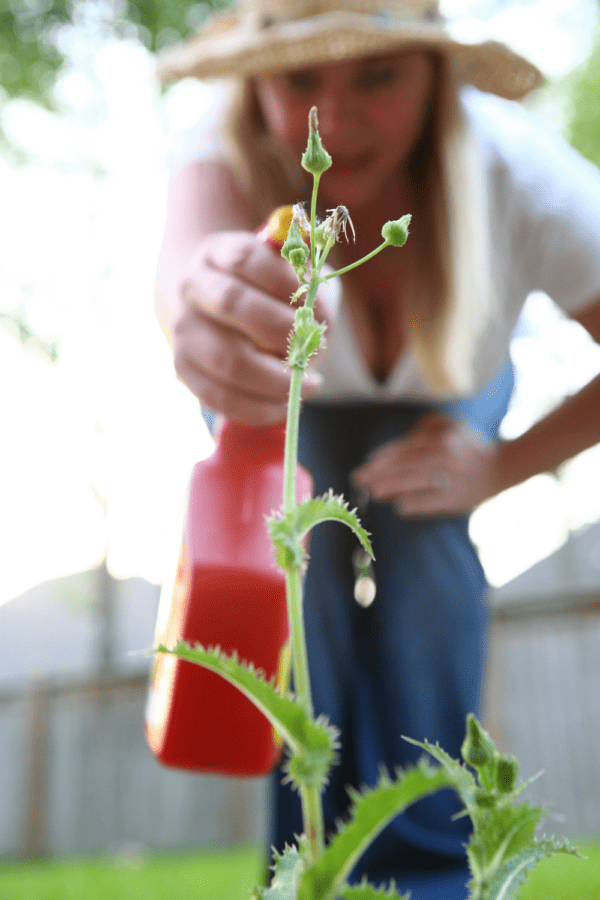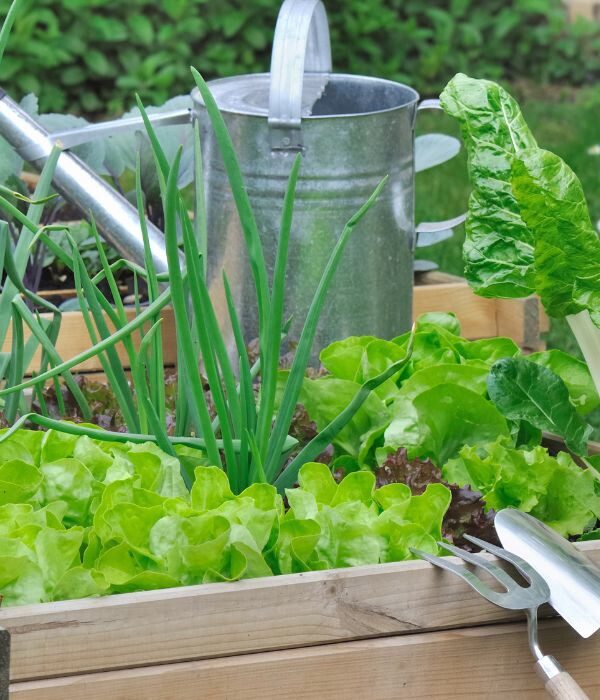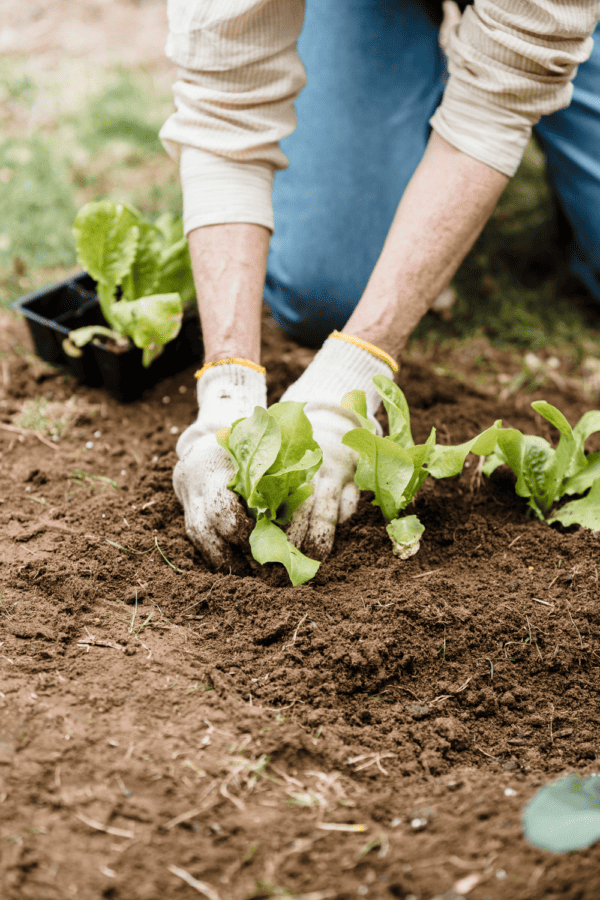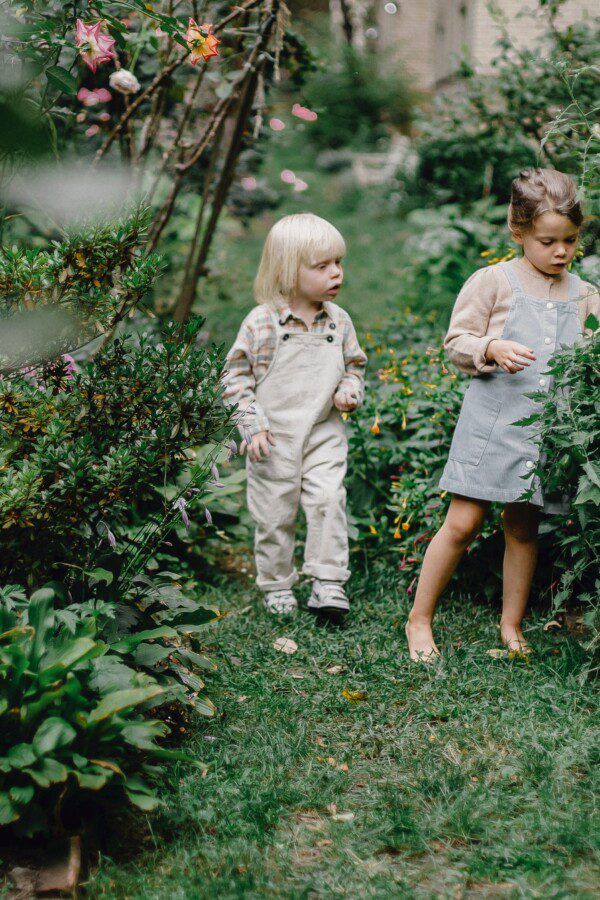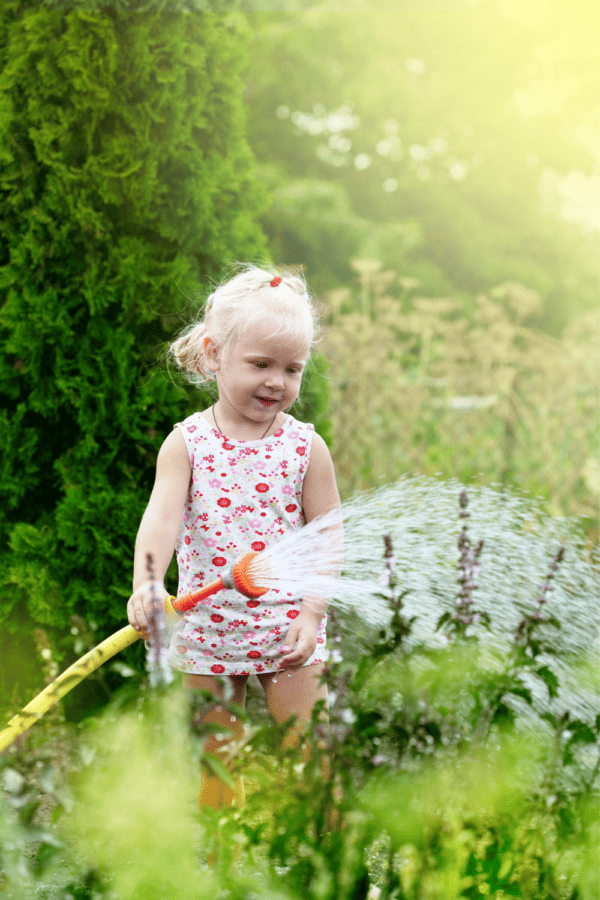Keeping ourselves, our kids, and our pets safe while we live and play on our lawns is obviously important, but conscious citizens will also want to do what they can to protect pollinators, our soil, our waterways, and our overall environment as well.
In this guide, I’m giving you some relatively simple ways to practice safer and more eco-friendly lawn care that uses less synthetic chemicals and is healthier for the pollinators and your family!
Table of Contents
1. Don’t Mow (Or Mow Less)
Not mowing is quickly becoming a trendy thing to do, as citizens realize that preserving the health of our environment is more important than “keeping up with the Joneses” with a perfectly clean-cut lawn.
Consider participating in no-mow May, or better yet, quit mowing altogether and start a pollinator-friendly yard that the bees and butterflies can benefit from all spring and summer long. (More on that in a minute.)
Of course, some municipalities and HOAs have rules about what your lawn is supposed to look like, so depending on where you live, it might be more difficult for you to get away with not mowing.
One couple in Maryland, Janet and Jeff Crouch, actually went through a legal battle after their HOA told them to remove their wildlife-friendly garden. The lawsuit actually ended up changing the law in Maryland so that HOAs can no longer force homeowners to have lawns. Well done, Crouches!
But even mowing less often can help. Grasses that are a few inches longer can help slow weed growth without the use of pesticides simply by providing more shade for weed roots. Longer grass can also help the blades grow deeper roots, which aids in a more resilient lawn overall.
Leave the Grass Clippings on the Lawn
If and when you do mow, leave the grass clippings where they are.
This practice, known as “grasscycling,” offers several benefits for both your lawn and the environment. When you mow your lawn and leave the clippings behind, they act as a natural fertilizer, returning valuable nutrients like nitrogen, potassium, and phosphorus back to the soil. This helps to improve soil health and fertility over time, promoting healthier grass growth.
Additionally, grass clippings left on the lawn can help retain moisture in the soil, reducing the need for frequent watering. They also act as a natural mulch, helping to suppress weed growth and reduce the need for chemical weed killers.
Overall, grasscycling is a simple and effective way to promote a healthier, greener lawn while reducing waste and environmental impact.
Alternatively, you could use your grass clippings to make your own PFAS-free garden fertilizer.
2. Choose Native Grass or Other Ground Cover
If you want or need to plant new grass on your lawn, be sure to choose grasses and other plants that are native to your area.
Native grasses and plants are easier to take care of, require less water and pesticides, are more resilient, and better for pollinators.
You may want to go with a ground cover other than grass, especially if you live in an area that doesn’t get a lot of rain or if you just want some more variety in your lawn. Epic Gardening has a great guide to using cover plants either instead of or in addition to normal grass.
And whatever you do, don’t replace your natural grass with artificial turf. It’s filled with all kinds of toxic chemicals.
3. Cultivate a Wildflower Garden
Pollinators like bees and butterflies tend to be even more sensitive to the toxic effects of pesticides than humans and other animals. Not only are they an important part of our ecosystem as a whole, but they also are crucial to humans’ food supply.
There are a few different ways to create a pollinator friendly yard. You could either add more native flower and/or vegetable gardens around your yard (which will require more maintenance but will be easier to get past the HOAs)…
Or instead of a more conventional garden, you could let the grass grow while also planting native wildflowers. You might consider starting with just one section of your lawn to see how things go, and then gradually expand that section each year. (Keep in mind that it will likely take a couple of years before you get a “pretty looking” wildflower lawn.)
It’s relatively easy to start cultivating a pollinator-friendly lawn. You’ll need to do a quick search on what wildflowers are native to your area and then ideally seed them in early spring. Learn more about how to start and maintain your bee-friendly lawn.
And if you’re afraid of what the neighbors might think, you can even put up a sign to let others know what’s up!
You could also incorporate other wildlife-friendly habitats, such as bird feeders!
4. Choose Organic & PFAS-Free Fertilizers
Unfortunately, most of the fertilizers on the market are contaminated with PFAS.
This is mostly because they use biosolids, which are contaminated with PFAS in a number of different ways.
You can learn more all about this issue right here (and see which brand of fertilizer we recommend).
In general, choosing a non-biosolid fertilizer is your best bet (for example, one that’s made of mushrooms or other plant-based materials). If you can make your own fertilizer out of organic food scraps, that’s even better.
5. Choose Safer Weed Killers (Or Pull Weeds By Hand!)
When it comes to weed control, you want to use the least amount of synthetic chemicals as you can.
- Pulling weeds by hand is the best option. Getting your hands in the soil is generally very healthy for you, but if you think there may be poison ivy, oak, or something similar, then put on your gardening gloves.
- Your second best option is to use natural (and low-cost!) ingredients that you probably already have in your kitchen. For example, things like vinegar and boiling water can go a long way in weed control. Here are some DIY weed killer recipes.
- Lastly, if you do buy store-bought herbicides, skip the toxic chemicals like 2,4-D and glyphosate and use non-toxic weed killer brands like these.
6. Conserve Water
Water conservation is crucial in lawn care, especially in regions prone to drought or water restrictions. By conserving water, you not only save money on your water bill but also help protect the environment by reducing water waste.
One of the most effective ways to conserve water in lawn care is to use rain barrels to collect rainwater for later use. This harvested rainwater can then be used to water your lawn and garden, reducing the need for treated tap water. (Rainwater also has less toxins in it, including PFAS.)
Another tip for efficient watering is to use drip irrigation systems, which deliver water directly to the base of plants, minimizing evaporation and runoff. Drip irrigation systems are particularly useful in areas with water restrictions, as they can deliver water precisely where it’s needed, reducing waste.
To further reduce water waste, consider watering your gardens during the early morning or late evening when evaporation rates are lower.
Additionally, choosing native and/or drought-resistant plants for your lawn and garden can significantly reduce water usage, as these plants are adapted to thrive in dry conditions with minimal watering.
Lastly, you may want to choose a garden hose that is free from things like lead, BPA, and phthalates, especially if you’ll be using it to water your vegetable garden.
7. Find an Organic Lawn Care Company Near You
If you have specific needs or problems, or if you’d rather just not do the work yourself, you’ll want to hire a lawn care company that cares about non-toxic products and potentially even native plants as much as you do. Watch out for greenwashing in this area because many companies will pay lip service to safety, but without actually backing it up.
Don’t be afraid to ask the company questions about the products, ingredients, and methods they use. If they aren’t willing to be transparent with you, consider that a yellow flag.
One relatively quick way to find out if the lawn care products they use are truly non-toxic is to ask if kids and pets can be on the lawn right after application. If they say no, then whatever they’re using may not be as safe as you want it to be.
More Guides for Safe, Natural Lawn Care:
I hope this guide has given you some ideas for how to create a safe, natural lawn without the use of toxic pesticides or artificial turf!
To stay updated on the latest guides, environmental toxin news, and other exclusive content, sign up for Filtered Fridays!


